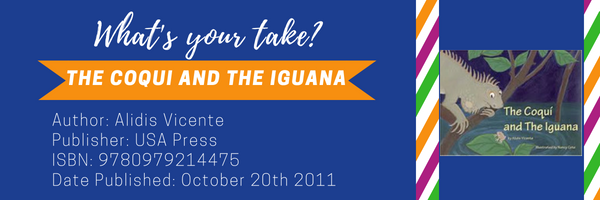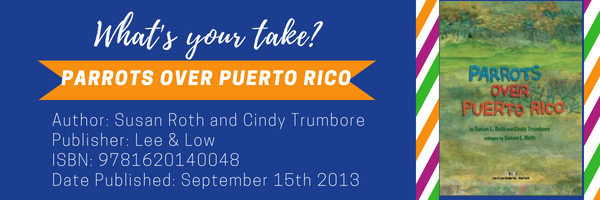This July, René Picó and Charlene Klassen Endrizzi explore the cultural complexities of the Puerto Rican experience. Many layers of idiosyncrasies can be uncovered within these books by the reader. The aim is to reveal how Puerto Rico “is a human archipelago… self-assertive, puzzling and contradictory.”
Our search for Puerto Rican picturebooks continues as we focus on the rich eco-diversity of our Caribbean island. We hope to fascinate readers with the sights and sounds of the distinctive Puerto Rican wildlife (including parrots, coquís and iguanas) through our discussion of The Coqui and the Iguana and Parrots Over Puerto Rico.

René: Growing up in the farming town of Ciales, Puerto Rico, I distinctly remember the sounds of the coqui lulling me to sleep every night. Who can forget! Now when I call home to Puerto Rico and talk with my parents in the evening, I still hear the same high-pitched, repetitive coqui vibrations.
Our first book this week by Alidis Vicente, The Coqui and the Iguana, offers a glimpse into the contrasting lives of two Puerto Rican children–a girl de acá (from here) and her cousin Sebastian, de allá (from there). The story illustrates some of the cultural differences and clashes between mainland Puerto Ricans who visit the motherland for the first time and Puerto Ricans who live on the island. These clashes are not exclusive to our characters but common to the human experience. Any city child visiting the countryside for the first time likely feels uncertain when facing a new life perspective. The author uses a second simultaneous focus on nature along the coastal ecosystem of southern Puerto Rico as a backdrop. Readers are invited to consider a second relationship between a tree frog (the coquí) and an iguana amidst the mangroves and bioluminescent waters of La Parguera.
Charlene: I was quickly drawn into contrasting narratives woven together by Alidis Vicente. The rendezvous between the two cousins balanced against the encounter of the coqui and iguana helps me consider both the human and environmental narratives of Puerto Rico. This introduction to the island’s weather, landscape and organisms invites me to want to know more. Descriptors like “mysterious creatures” (mosquitos, snakes, the tiny tree frog or coqui and of course the iguana) create a desire for further inquiry.
As an avid sightseer I view travel as a gateway into new stimulating worlds. Vicente reminds me of other human reactions to the unknown through the lens of a child. Our Puerto Rican girl from the mainland seems afraid but also inquisitive about her parents’ motherland. Even the illustrations demonstrate her uncertainty through her crossed arms and worried eyes. Her cousin Sebastian, on the other hand, appears relaxed with his smiling face and arms hanging out of their boat. Terms like “creepy”, “monsters” and “mysterious” evoke a tone of suspense. The one code-switching example (“Don’t worry, prima”) makes me wish for more to portray linguistic differences further.
René: Beyond the telling conversations about differences within a culture, visits to relatives and new environmental challenges, I did not mind the brief moralist tone in the story when the iguana tells the frog, “Coqui, even in the darkest places there is always a light…” From a child’s perspective, I realize that many common adventures may seem mysterious and challenging. The exploration of environments–natural, cultural, intellectual or spiritual–are fantastic opportunities to gain knowledge and skills. We all need time to consider how new environments and cultures are not good or bad; they are just different. We can support children’s developmental skills to learn from differences and absorb these experiences as meaningful memories and inspiration for future encounters. These differences might be encountered through our interactions with newcomers at school, visits to relatives or travel to locations near and far.
Charlene: Your insights help me realize how our first book The Coqui and the Iguana offers a strong, human, fictional lens which makes me appreciate the strong environmental, non-fiction lens of our second book, Parrots Over Puerto Rico. I keep returning to the importance of fiction and nonfiction book pairs, enabling readers with distinct interests to see our world from diverse viewpoints.

I appreciate Susan Roth’s painstaking collages, readily recognizable from her distinct ability to cut and tear paper and fabric. Her efforts to re-use extra scraps can inspire readers to expand on or appreciate current recycling efforts. Her artwork draws me into the Puerto Rican eco-scape filled with parrots and their ultimate nemeses, the red-tailed hawks and the pearly-eyed thrashers. Roth’s and Cindy Trumbore’s nonfiction narrative retells the perilous history of endangered Puerto Rican parrots.
At first I misidentified the island terrain as a rainforest. Further research reveals how Puerto Rico and the larger Caribbean lost most of her native rainforest. What remains are patches of mostly tropical forest, some natural reserves–one of them, El Yunque National Forest, is the only tropical rainforest in the US Forest Service. Along the island’s coasts, one can find mangrove forests growing in the brackish waters of the Atlantic and the Caribbean Sea. Within this rich eco-diversity, where do your parents live?
René: My parents live in Ciales right in the middle of the island. My hometown is known as one of the gates to the Cordillera Central. My family’s farm is in the middle of a dense patch of woods, considered a tropical forest. Thick woods give the impression of living in the middle of a jungle which suddenly opens to a valley of coffee and banana fields. My childhood experiences at the farm parallel encounters of the researchers in our text, studying the creatures roaming the land. My family and I enjoyed the flight of hundreds of parrots (unfortunately not the Puerto Rican parrots) and other bird species when walking or riding horses throughout the forest.
Teachers can use Roth’s and Trumbore’s book as an introduction into the scientific study of birds, specifically of the Puerto Rican parrots, thereby launching a more extensive exploration of this unique endangered species. Ricardo Valentin de la Rosa, mentioned in the Afterword, was an acquaintance of mine at the University of Puerto Rico Mayaguez in the 1990s. It would be amazing to take a study trip to his Rio Abajo Aviary, the second aviary dedicated to raising Puerto Rican parrot chicks, where scientists train them to avoid predators and release them back into the wild. Additionally teachers and students reading this book can perform research to find current information about how the aviary and its Puerto Rican parrot population is recovering after Hurricane Maria hit the island in September 2017.
Parrots over Puerto Rico coupled with The Coqui and the Iguana offer the beginning of a marvelous STEAM experience in the classroom. [S]cience of ecosystems connects with the data collection and graphing of [M]athematics, that intersects with the [E]ngineering in the construction of the Puerto Rican parrot nests. This STEAM experience also nurtures the gathering of information via [T]echnological tools (searches, sites, maps) and expresses itself in an array of [A]rchitectural and [A]rtistic exhibitions of tropical rainforests, parrots and parrots nests. And let us not forget a social studies overlay with the study of Puerto Rico, its geography and its people. These texts can launch a powerful children’s integrative learning experience.
Title: The Coqui and the Iguana
Author: Alidis Vicente
Publisher: USA Press
ISBN: 9780979214475
Date Published: October 20th 2011
Title: Parrots over Puerto Rico
Author: Susan Roth and Cindy Trumbore
Publisher: Lee and Low
ISBN: 9781620140048
Date Published: September 15th 2013
This is the third installment of July’s MTYT Series. We talked about Arturo Schomburg first and discussed Roberto Clemente and Tito Puente last week. Check back next week to follow the conversation
